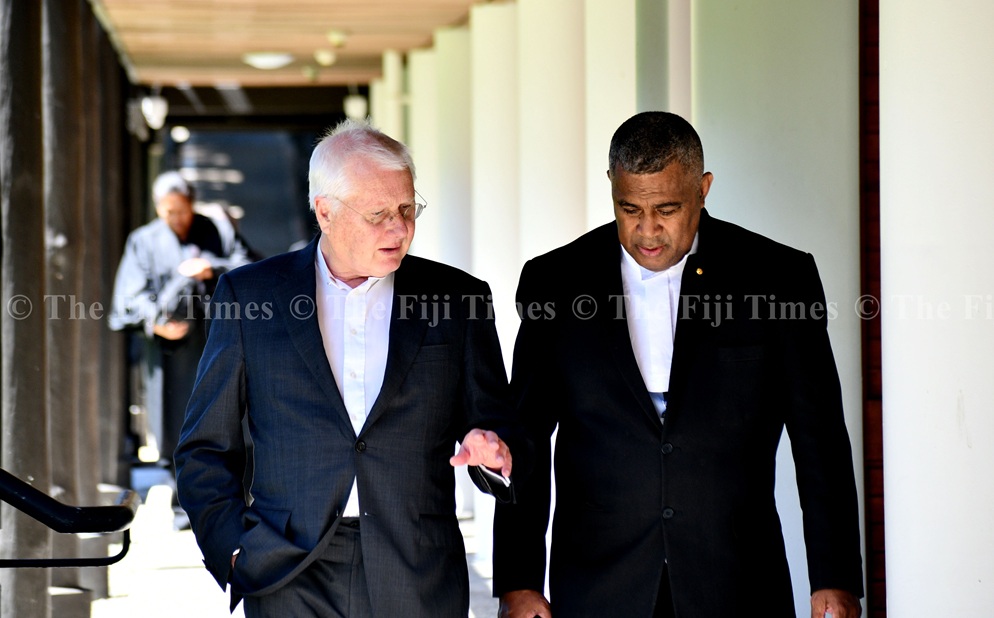The Supreme Court heard arguments that could redefine Fiji’s constitutional future, with lawyers insisting the 1997 Constitution still stands and that the 2013 Constitution was illegitimate and invalid from the beginning.
“The 1997 Constitution was developed with full public participation and approved by Parliament,” said Ratu Tevita Vakalalabure, counsel for the Minister for Policing Ioane Naivalurua-led group. By contrast, he argued, the 2013 Constitution lacked those foundations.
Ratu Tevita reminded the court of Sitiveni Rabuka’s words when introducing the 1997 Constitution: “What will give legitimacy to our constitution is the principle that it has been developed with the free and full participation of everyone… it provides for a system of Parliamentary Government based on the consent of the people.”
“That… is the benchmark of legitimacy the people of the Republic of Fiji have set for themselves. By that standard, a constitution drafted by a handful of officials, without the people of Fiji’s informed participation or consent, cannot claim lawful legitimacy today or fifty years from now.”
“A rogue act”
Social Democratic Liberal Party (SODELPA) counsel Jolame Uludole built on that argument, describing the abrogation of the 1997 Constitution in 2009 as “a rogue act of the then interim government,” contrary to law, invalid and illegal.
He said the 2013 Constitution lacked broad agreement among the people.
“The 2013 Constitution is not a consensus document as it does not reflect a set of principles that all citizens in a country can agree upon,” Mr Uludole said, pointing to the fact that even Government had branded some of its provisions “inoperable.”
Mr Uludole urged the court to declare the 2013 Constitution invalid and reinstate the 1997 order. But he also recognised the complexities of such a move.
To avoid upheaval, he proposed that the current Government be designated as an interim administration until fresh elections could be held under the 1997 framework.
“We understand a lot of work will be necessary, which cannot be done overnight,” he said.
“The court can rule that the government actions taken under the 2013 Constitution must remain valid to avoid upheaval.”
“The bridge itself”
Councel for the People’s Alliance party Simione Valenitabua echoed SODELPA’s position, stressing that the constitutional question had lingered unresolved in Fiji’s politics for too long.
“This issue keeps coming up,” he said.
“My clients, as a political party, continue to be asked about it.”
Mr Valenitabua rejected arguments that the 2013 Constitution had gained legitimacy through the passage of time or through two general elections held under its rules.
“Yes, my lord, there’s been so much water under the bridge. But the 1997 Constitution, we submit with respect, is the bridge itself. Everything that has happened from 2009 until now is the water under it.”
He referred to the 2013 Constitution as illegitimate and invalid from the beginning and emphasised that it had been drafted “by a small number of people” without public participation.
He described the 2009 abrogation of the 1997 Constitution as “an assault on the judiciary.”
Mr Valenitabua outlined a three-step solution to resolve the issue: first, judicial recognition of the 1997 Constitution as the lawful supreme law; second, validation of actions taken under the 2013 framework to preserve continuity; and third, the establishment of an interim administration to oversee a managed transition.
He dismissed concerns that this path would spark instability, describing it instead as a “practical and lawful solution.”
“Great violation of rights”
Unity Fiji Party lawyer Naomi Raikaci said only the 1997 Constitution had been founded on broad-based public consent.
She also reminded the court of the human cost surrounding the adoption of the 2013 Constitution.
“During the last 16 years there was a great violation of rights and people who wanted to protest the 2013 Constitution were stopped, taken to the army camp,” she said.
A clash of legal orders
Together, the intervenors presented the narrative that Fiji stands between two competing constitutional orders. One, the 1997 Constitution, was the product of broad consultation, parliamentary debate, and democratic consensus. The other, the 2013 Constitution, was imposed by decree, shielded from amendment, and lacking in public legitimacy.
Their submissions invited the Supreme Court to confront head-on the question that has hovered over Fiji’s politics for more than a decade: whether a document imposed by a small group can truly serve as the foundation of the nation’s democracy.
The stakes
For Fiji, the stakes are immense. A ruling that affirms the 1997 Constitution could mark a dramatic reordering of the legal and political landscape, reopening questions about governance, elections, and the legitimacy of laws passed since 2009.
Conversely, a decision upholding the 2013 framework could entrench the existing order, despite the lingering doubts voiced by political parties and their legal representatives.
What is clear from the Constitution Reference hearing so far is that the debate is not merely about technicalities in sections 159 and 160. It is about the deeper question of where Fiji’s constitutional legitimacy truly lies, in a document shaped by consultation and consensus, or one imposed by decree in the wake of upheaval.
The hearing continues in the Supreme Court today.

